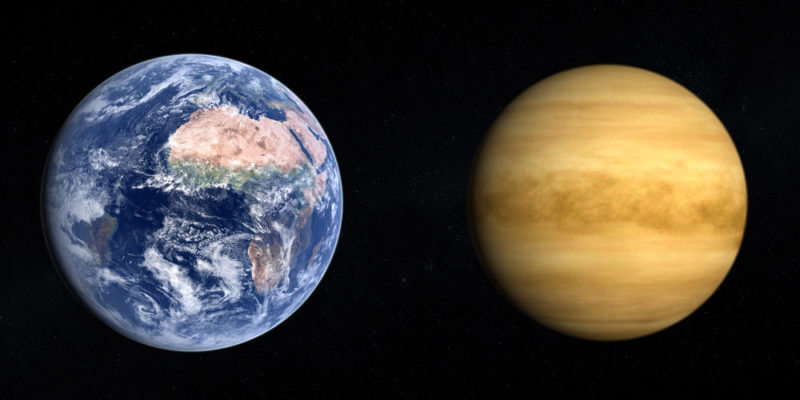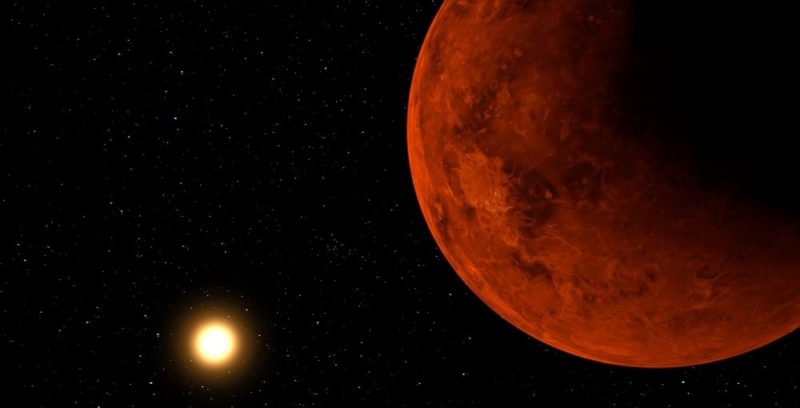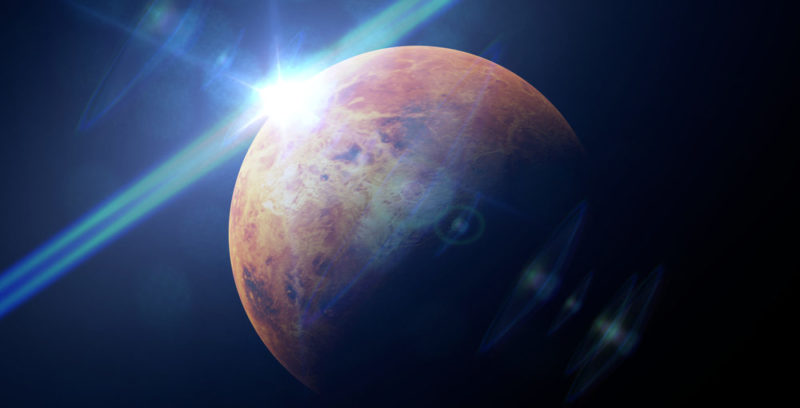We explain what Venus is, where it is located, and its dimensions. Also, what are its characteristics, atmosphere, and lights of Ashen?
What is Venus?
Venus is the second closest planet to the Sun in our Solar System and the sixth in terms of size (from largest to smallest), named in honor of the Roman goddess of love and seduction, the same one that the Greeks called Aphrodite.
It is a rocky, terrestrial planet, similar in size, mass, and composition to our planet, which is why it has often been considered its "sister" planet. However, it is completely different when it comes to temperature, atmosphere, and pressure.
This planet has been observed by humanity since ancient times, since it is one of the three stars visible to the naked eye during the day (along with the Moon and the Sun ), being the third in brilliance (after the Moon). Given its appearance after sunset or sunrise, it has been baptized as the "morning star" and is part of many poetic compositions, traditional astrological theories, and ancient calendars.
Venus location
The orbit of Venus is located between those of Mercury and Earth, about 108.2 million kilometers from the Sun and barely 40 million kilometers from Earth, being the closest planet to ours that exists.
Dimensions and satellites of Venus

Venus has a diameter of 12,103.6 kilometers and a volume of 9.28 x 10 11 cubic kilometers (equivalent to 0.86 times that of Earth), in addition to a mass slightly less than that of our planet (0.815 times).
It is a lonely planet, without satellites of any kind.
Venus orbital data
The orbit of Venus is the roundest of all in the Solar System (eccentricity of less than 1%) and lasts about 584 days. This displacement around the sun (translation) occurs at an average speed of 35.02 kilometers per second.
The planet also exhibits a slow rotational movement, which takes 243.01 Earth days to complete, and which occurs in the opposite direction to the rest of the planets (except Uranus).
This means that a Venusian day-night cycle would take about 116.75 Earth days, and a Venusian year just 1.92 of these cycles.
Atmosphere of Venus
The pressure and temperature of Venus are extremely high, due to the composition of its atmosphere, mostly greenhouse gases. This pressure is 90 times greater than that of the Earth and its average temperature is 463.85 ° C (hotter than Mercury, despite being twice the distance from the Sun).
The Venusian atmosphere is mainly composed of carbon dioxide (96%) together with gases such as nitrogen (3%), sulfur dioxide (0.015%), water vapor (0.002%), carbon monoxide (0.0017%), argon (0.007%), helium (0.0012%) and neon (0.0007%). This dense layer of clouds almost completely prevents the arrival of solar radiation to the surface of the planet, so without it, its temperature would be similar to that of the Earth.
Geology of venus

Almost all (90%) of the surface of Venus consists of a basalt (igneous rock) with very few meteorite impacts (and therefore few craters), whose oldest formations do not appear to predate 800 million years (recent, in planetary time).
The planet has two great plateaus-like continents, raised on a wide plain: Ishtar Terra (north) and Aphrodite Terra (south). The first is equivalent to the size of Australia, the second that of all of South America.
It is assumed that the heart of the planet is similar to that of the Earth (cast iron), with a rocky mantle around it, interrupted by frequent volcanoes that constantly coat the surface with fresh lava.
The magnetic field of the venus
Unlike Earth, whose rotation and iron core provide its own magnetic field that rejects solar radiation emissions, Venus receives them entirely, since it lacks this magnetic shield.
This, according to the planet's scholars, could have caused the decomposition of existing water into hydrogen and oxygen: the former would escape into space due to its low molecular mass, while the latter would combine into atmospheric carbon dioxide. It is one of the explanations why there is no life as we know it, being a planet in principle similar to ours.
Transits of Venus
It is known as the "transits of Venus" to the rare occasions in which the planet is interposed between the Sun and the Earth, which makes it possible to study certain characteristics of its composition. During his 1761 transit, for example, Mikhail Lomonosov found the first evidence that Venus has an atmosphere. This occurs only in June or December, in pairs separated by eight years (for example, in 2004 and 2012), and separated from the next pair by almost a century.
Phases of Venus

From the Earth, the phases of Venus can be observed, just like those of the Moon. Galileo Galilei was the first to spot them in 1610, noting the changes in their perceptible size and correctly interpreting them as the fact that the star was further away from us.
Venus shines brightest when 25% of its surface is illuminated by the Sun, which occurs 37 days before its conjunction with Earth in the evening sky and 37 days after it in the morning sky.
Ashen lights
This is the name given to an unexplained phenomenon that takes place in the nocturnal half of Venus, and that consists of a yellowish or whitish halo emitted by the planet. It was first observed in 1643 using telescopes, and numerous explanations have been attributed to it, from visual illusions to electrical storms.
Venus symbol

In astronomical notation, Venus is represented by the same symbol that traditionally designates the female sex, a circle with a small cross underneath.
The above content published at Collaborative Research Group is for informational and educational purposes only and has been developed by referring to reliable sources and recommendations from technology experts. We do not have any contact with official entities nor do we intend to replace the information that they emit.
MA student of the TransAtlantic Masters program at UNC-Chapel Hill. Political Science with a focus on European Studies. Expressed ideas are open to revision. He not only covers Technical articles but also has skills in the fields of SEO, graphics, web development and coding. .
Leave a reply
Your email address will not be published. Required fields are marked *Recent post

Sport: What Is It, Types, Risks, Features, Characteristics and Examples

Dogs: Emergence, Features, Characteristics, Feeding and Breeds

Story: Definition, Elements, Structure, Features and Characteristics

